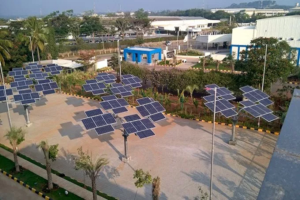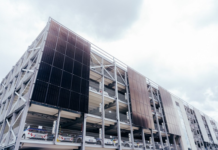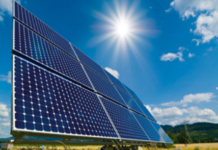
There’s now a constant buzz around the solar sector in India. The government’s intention to build 56 solar cities in the country and using the sun to power homes is adding to the excitement. However, there are bound to be challenges since modern urban areas are power guzzlers and there will be space constraints when it comes to installing solar systems. To enable the installation of more solar panels within cities, where power generated can be consumed directly, innovations like the MWS SmarTree appear a viable option.
“With the concept of smart cities being promulgated by policy makers, we recognised that solar will emerge as the most critical component in the success of these programmes,” Siddharth Malik, CEO of Megawatt Solutions, told indiaclimatedialogue.net.
Conventional photovoltaic (PV) installations need a large installation area and have relatively lower output in units per kilowatt (kW). These are further highlighted when solar is adopted for urban areas, since land is at a premium and there is a need to ensure high output from a given installation that also blends with the urban architecture and landscape.
Space optimiser
In such cases, SmarTree, an innovation of Megawatt Solutions, is ideal for ground-mounted installations. It has the least ground space requirement and has helped overcome the problem of land constraint, which is the case with fixed PV structures. A 5 kWp SmarTree occupies less than 0.25 sq. m of ground. Compared with this, conventional 5kWp occupies almost 50 sq. m of ground.
The low energy output of conventional PV systems can render the installation of limited use in urban areas. Though the aesthetic nature of such solutions has rarely been the focus, it will assume greater importance for urban areas. Since the need for a new aesthetic configuration, with high energy output, least ground footprint and indigenous availability was felt, the MWS SmarTree was created as it addresses these constraints and is the future of solar in urban areas.
“Moreover, in areas such as car parking lots, parks, golf course, plazas, beaches and compounds, people are always looking for aesthetic solutions for shade from sunlight. In such a scenario, we felt that an aesthetic solar solution can provide shade and generate electricity. Inspired by nature, we created SmarTree, where a considerable number of solar panels can be installed while keeping ground space free and for better use than before,” says Malik.
SmarTree is equipped with a single axis tracker that keeps solar panels always aligned towards the sun. This allows the panels to “see” a much greater component of incoming light and generate up to 25% higher output from same panel area. Since the tracker is self-powered, it requires no auxiliary power consumption. Indigenously designed and engineered, it needs practically no maintenance and comes with extended warranties. The SmarTree is designed to withstand up to 200 km per hour wind speeds.
Smarter cities with solar
Owing to rising levels of pollution in cities due to vehicular traffic, the concept of electric vehicles (EVs) is gaining credence. A case in point is the new range of solar powered e-rickshaws that were unveiled at the EV Expo in New Delhi recently.
However, one of the biggest challenges has been the availability of charging points. SmarTree has been designed with configurable ground clearances to accommodate various electrical vehicles and can be easily installed on highways and parking lots, thereby helping the cause of EVs.
As of now, it has been installed at car parks, corporate and industrial parks, hotels, academic institutions and real estate projects in cities such as Bengaluru, Hyderabad, Chennai, Indore, Noida, Lucknow and Baroda. In the next few years, it is likely to emerge as a natural solution for India’s smart cities, believes Malik.
Solar axis tracker
Yet another initiative has been the solar axis tracker. Explaining what inspired its creation, Malik says, “In conventional solar power plants, there is an increased stress on land availability and pressure on falling tariffs. This creates a challenge for project developers to meet project returns. Hence, the need was felt to drastically increase the energy output of conventional solar PV power plants and in that sense, a solar tracker is an effective seamless and an economical way to achieve it.”
Indigenously developed, it is one of the most economical in the global market and is a feasible solution for the industry.
There are two types of conventional PV trackers. One, the row-based trackers and the other, block trackers. The row-based trackers have imported components, which make them expensive. The block trackers rely on linking multiple roles on a single tracker, thereby reducing reliability, redundancy and the overall uptime. The trackers also require auxiliary power, thus reducing the net gain expected from the tracker solution.
In contrast, the MWS tracker is self-powered, has high reliability, requires minimum civil work and is totally indigenously. It allows both vertical and horizontal panel mounting configurations to suit a particular site. Each row allows over 32 kW within a 50-meter row length.
Malik says they have adopted a delivery model which enables the Engineering Procurement Construction (EPC) company to take advantage of the tracker while limiting their exposure to any sort of technical or financial risk. “The typical scope of supply includes design of civil foundations, supply of structure, tracking drive, tracker controls, installation of the above and panel mounting.”
“On a case-to-case basis, we are flexible to customize it. Further, we provide an uptime warranty of more than 99% for EPC customers which allow seamless integration of trackers with minimum risk,” he adds. The MWS tracker is at least 30% cheaper than others in the market now. Malik says, “Discussions for implementing up to 200 MW using MWS trackers are on, with a confirmed pipeline of 70 MW.”
Source: http://indiaclimatedialogue.net/


















